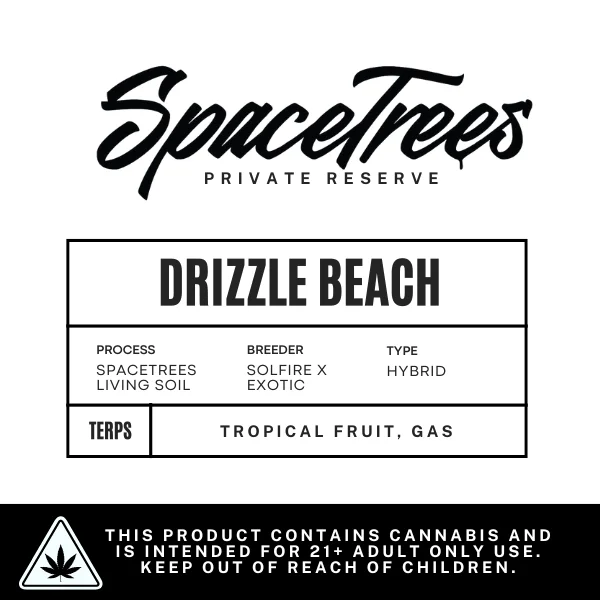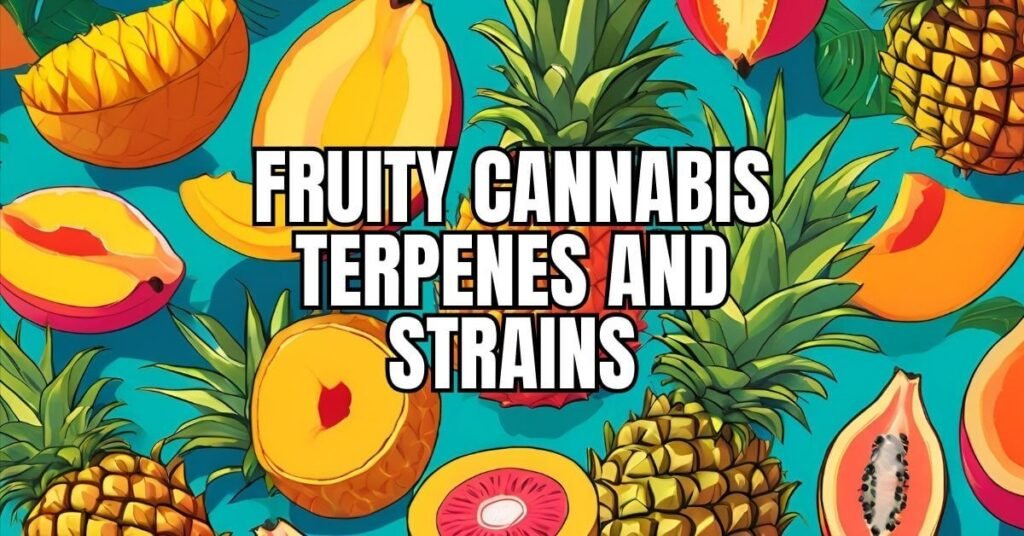
Table of Contents
- Understanding Fruity Terpenes in Cannabis
- Primary Fruity Cannabis Terpenes
- Limonene: The Citrus Terpene
- Myrcene: The Tropical Fruit Terpene
- Terpinolene: The Berry and Apple Terpene
- Ocimene: The Sweet Tropical Terpene
- Valencene: The Orange Terpene
- Popular Cannabis Strains with Fruity Terpenes
- Sub-Categories of Fruity Terpene Profiles
- Therapeutic Benefits of Fruity Cannabis Terpenes
- Cultivation Techniques for Enhanced Fruity Terpene Profiles
- Consumer Guide to Cannabis with Fruity Terpenes
- Fruity Terpenes in Cannabis Concentrates and Extracts
- Frequently Asked Questions About Fruity Cannabis Terpenes
Understanding Fruity Terpenes in Cannabis
Fruity terpenes create some of the most appealing and accessible aroma profiles in the cannabis world. From bright citrus notes to tropical mango hints and sweet berry undertones, these compounds produce a diverse spectrum of fruit-like aromas that have become increasingly popular among cannabis enthusiasts and medical users alike.
Cannabis varieties rich in fruity terpenes offer:
- Sweet, inviting aromas reminiscent of familiar fruits
- Often vibrant flavor profiles that translate well when consumed
- Diverse effect profiles ranging from energizing to relaxing
- Frequently, a more approachable experience for cannabis newcomers
Fruity cannabis terpenes make cannabis more accessible to those who might be put off by the more pungent or earthy aromas found in other varieties. Beyond their appealing scents, these compounds contribute to therapeutic effects that range from mood elevation to inflammation reduction.
In this comprehensive guide, we’ll explore the primary fruity terpenes in cannabis, examine notable cannabis strains that showcase these profiles, and discuss the potential benefits and applications of fruity-dominant cannabis varieties.
Primary Fruity Cannabis Terpenes
Several terpenes contribute to the diverse range of fruity aromas found in cannabis. Let’s examine the key compounds responsible for these delightful scents:
Limonene: The Citrus Terpene
Limonene creates the characteristic scent of citrus fruits and is one of the most recognizable fruity terpenes in cannabis.
Aroma Profile:
- Bright citrus
- Lemon and orange peel
- Fresh and zesty
- Slightly sweet
Also Found In:
- Citrus fruit rinds
- Juniper
- Peppermint
- Many cleaning products
Potential Benefits:
- Mood elevation
- Stress reduction
- Anti-anxiety effects
- Potential anti-depressant properties
- Anti-inflammatory effects
- Potential digestive benefits
What Makes It Special: Limonene is readily absorbed in the body and can cross the blood-brain barrier, which may explain its rapid effects on mood and stress. Its molecular structure allows it to increase the absorption of other cannabis terpenes and compounds, potentially enhancing the overall therapeutic effect of cannabis varieties containing significant limonene.
Notable Research: A 2021 study published in Frontiers in Psychiatry highlighted limonene’s potential as an anti-anxiety and anti-depressant compound, noting its ability to modulate serotonin and dopamine in the brain. Additional research has demonstrated its anti-inflammatory properties, with potential applications for conditions involving chronic inflammation.
Myrcene: The Tropical Fruit Terpene
While often associated with earthy aromas, myrcene at certain concentrations produces distinct tropical fruit notes, particularly mango, making it an important fruity cannabis terpene.
Aroma Profile:
- Musky
- Tropical fruit (mango, particularly)
- Slightly herbal
- Sweet earthiness
Also Found In:
- Mangoes
- Hops
- Lemongrass
- Bay leaves
Potential Benefits:
- Relaxation and sedation
- Potential pain relief
- Anti-inflammatory properties
- Muscle relaxant effects
- May enhance the effects of THC
What Makes It Special: Myrcene is the most abundant terpene in commercial cannabis, often accounting for over 50% of the terpene profile in many strains. Its concentration appears to influence whether a cannabis variety will produce sedating or more balanced effects. At higher concentrations, myrcene produces more pronounced fruity terpene aromas and potentially stronger sedative effects.
Notable Research: Research published in the British Journal of Pharmacology demonstrated myrcene’s analgesic properties, while other studies have confirmed its muscle relaxant effects. Perhaps most intriguingly, research suggests that myrcene may increase cell membrane permeability, potentially enhancing the absorption of cannabinoids and explaining the anecdotal “mango effect” where consuming mangoes before cannabis may intensify the experience.
Terpinolene: The Berry and Apple Terpene
Terpinolene contributes to apple, berry, and floral fruit notes in cannabis with fruity terpenes.
Aroma Profile:
- Fresh
- Apple and berry notes
- Piney undertones
- Sweet floral hints
Also Found In:
- Apples
- Cumin
- Tea tree
- Lilacs
Potential Benefits:
- Antioxidant properties
- Potential sedative effects
- Possible antibacterial properties
- May have cancer-fighting properties
What Makes It Special: Unlike many other terpenes, terpinolene is found in relatively low concentrations in most cannabis varieties, yet even in small amounts, it can significantly impact the aroma profile. It often works synergistically with limonene to create complex fruit-forward aromas. Interestingly, despite being present in many sedating cannabis strains, some research suggests terpinolene itself may have energizing properties in isolation.
Notable Research: Studies have demonstrated terpinolene’s antioxidant properties, with research published in Natural Product Communications showing it may help protect cells from oxidative damage. Other studies have explored its potential as a natural insect repellent and its possible antiproliferative effects against certain cancer cells.
Ocimene: The Sweet Tropical Terpene
Ocimene contributes sweet, tropical, and sometimes berry-like notes to cannabis fruity terpenes.
Aroma Profile:
- Sweet
- Tropical
- Herbaceous undertones
- Subtle berry notes
Also Found In:
- Mint
- Parsley
- Orchids
- Kumquats
Potential Benefits:
- Anti-inflammatory effects
- Antiviral properties
- Antifungal properties
- Potential decongestant properties
What Makes It Special: Ocimene tends to appear in more energizing, uplifting cannabis varieties. It’s often described as having a “bright” quality that contributes to the overall perceived freshness of a strain’s aroma. Ocimene is particularly abundant in some fruit-forward cannabis varieties with sativa-dominant genetics.
Notable Research: Research has focused primarily on ocimene’s potential as an anti-inflammatory agent. A study published in the Journal of Natural Products demonstrated its effectiveness against inflammatory responses. Other research has explored its antiviral and antifungal properties, suggesting potential applications in treating various infections.
Valencene: The Orange Terpene
Named after Valencia oranges, valencene contributes sweet citrus notes with distinctive orange characteristics to fruity cannabis terpenes.
Aroma Profile:
- Sweet orange
- Tangerine
- Fresh citrus peel
- Warm sweetness
Also Found In:
- Valencia oranges
- Grapefruits
- Tangelos
- Some herbs
Potential Benefits:
- Anti-inflammatory effects
- Potential antiallergic properties
- Possible insect repellent
- May offer skin protection benefits
What Makes It Special: Valencene is less common than other fruity terpenes but creates a distinctive sweet orange aroma that’s highly prized in certain cannabis varieties. It’s often found alongside limonene but creates a warmer, sweeter citrus note compared to limonene’s brighter, sharper citrus character.
Notable Research: Research published in Food and Chemical Toxicology highlighted valencene’s anti-inflammatory and anti-allergenic properties. Other studies have investigated its potential as a natural insect repellent and its possible protective effects against certain environmental stressors.
Popular Cannabis Strains with Fruity Terpenes
Several cannabis strains have become famous for their exceptional fruity terpene profiles:
Tangie
Dominant Fruity Terpenes: Limonene, valencene
Description: Known for its incredibly powerful orange aroma, Tangie offers an almost candy-like citrus experience that faithfully recreates the essence of tangerines.
Typical Effects: Uplifting, creative, energizing
Mango Kush
Dominant Fruity Terpenes: Myrcene, limonene
Description: True to its name, this strain offers a sweet, tropical mango aroma with subtle earthy undertones.
Typical Effects: Relaxing, euphoric, potentially sedating
Strawberry Cough
Dominant Fruity Terpenes: Ocimene, terpinolene
Description: Offers a distinctive sweet strawberry aroma with subtle herbal notes. The experience often includes a tendency to cause coughing, hence the name.
Typical Effects: Uplifting, euphoric, mentally stimulating
Forbidden Fruit
Dominant Fruity Terpenes: Myrcene, limonene, terpinolene
Description: Creates a complex tropical fruit aroma with notes of grapefruit, passion fruit, and berries, often complemented by floral undertones.
Typical Effects: Relaxing, mood-elevating, potentially sedating
Drizzle Beach
Drizzle Beach is one of the fruitiest, tropical gas cultivars and a true favorite with cannabis enthusiasts. Caked in trichomes and oozing with tropical fruit terpene aromas and gas, it represents a perfect example of how fruity cannabis terpenes can create complex and appealing profiles.


Sub-Categories of Fruity Terpene Profiles
The world of fruity cannabis can be further categorized into several distinct aromatic profiles, each with its own characteristics:
Citrus Terpene Profiles
Key Terpenes: Limonene, valencene
Characteristics: Bright, energizing aromas reminiscent of lemons, oranges, and grapefruits
Notable Strains: Super Lemon Haze, Clementine, Lemon Skunk
Typical Experience: Often associated with uplifting, energetic effects and mood enhancement
Tropical Fruit Terpene Profiles
Key Terpenes: Myrcene, ocimene
Characteristics: Sweet, exotic aromas reminiscent of mangoes, pineapples, and papayas
Notable Strains: Pineapple Express, Mango Kush, Maui Wowie
Typical Experience: Frequently creates balanced effects, often with relaxing body sensations alongside mental stimulation
Berry Terpene Profiles
Key Terpenes: Terpinolene, myrcene
Characteristics: Sweet, jammy aromas reminiscent of blueberries, strawberries, and other forest fruits
Notable Strains: Blueberry, Strawberry Cough, Blackberry Kush
Typical Experience: Often associated with relaxing, euphoric effects, particularly in indica-dominant varieties
Sweet Fruit Terpene Profiles
Key Terpenes: Myrcene, terpinolene, ocimene
Characteristics: Candy-like sweetness with general fruit notes that may not be specific to one fruit
Notable Strains: Fruity Pebbles, Zkittlez, Runtz
Typical Experience: Effects vary widely depending on cannabinoid content, but often feature a pronounced sense of euphoria
Melon and Cucumber Terpene Profiles
Key Terpenes: Ocimene, limonene in specific ratios
Characteristics: Fresh, cool, sometimes subtle fruit notes reminiscent of watermelon, cantaloupe, or cucumber
Notable Strains: Melon Gum, Cucumber Kush
Typical Experience: Often creates refreshing, clear-headed effects with moderate relaxation
Therapeutic Benefits of Fruity Cannabis Terpenes
Cannabis varieties rich in fruity terpenes offer several potential therapeutic applications:
Mood Enhancement from Fruity Terpenes
The limonene prevalent in citrus-forward strains has demonstrated mood-elevating properties in multiple studies. For those dealing with low mood or depression, these varieties may offer particular benefits. The bright, uplifting aromas themselves may also contribute to mood improvement through aromatherapeutic effects.
Stress Reduction from Fruity Terpenes
Many fruity terpenes, particularly limonene and myrcene, have demonstrated stress-reducing properties. Cannabis varieties combining these terpenes with moderate THC and CBD may offer effective stress relief without excessive sedation.
Nausea Management with Fruity Terpenes
Several fruity cannabis terpenes show promise for managing nausea and improving appetite. Cancer patients and others dealing with nausea have traditionally found benefit from fruity cannabis varieties, potentially due to both the cannabinoid and terpene content.
Inflammation Reduction from Fruity Terpenes
Research indicates that limonene, myrcene, and ocimene all possess anti-inflammatory properties. For patients managing inflammatory conditions, these fruity terpenes may complement the anti-inflammatory effects of cannabinoids like CBD.
Sleep Support from Specific Fruity Terpene Profiles
While many fruity strains are energizing, those dominated by myrcene (particularly tropical and berry profiles) can provide gentle sleep support. The sedative properties of myrcene combined with THC may help address insomnia with a more pleasant sensory experience than some of the more earthy, sedating varieties.
Cultivation Techniques for Enhanced Fruity Terpene Profiles
Cultivators seeking to maximize fruity terpene expression can employ several techniques:
Genetic Selection for Fruity Terpenes
The genetic foundation is the most important factor. Starting with cultivars known for pronounced fruity profiles provides the best foundation for terpene expression.
Nutrient Management for Terpene Production
Strategic adjustment of certain nutrients during flowering can enhance fruity terpene production:
- Slight reduction in nitrogen during late flowering
- Maintaining adequate phosphorus and potassium
- Ensuring sufficient sulfur, which is a building block of terpenes
Light Spectrum Optimization for Fruity Terpenes
Research suggests that including UV-B light and full-spectrum LED lighting during flowering can enhance terpene production. Many commercial growers are incorporating specific light spectrums during different growth phases to maximize fruity terpene expression.
Temperature and Humidity Control for Terpene Preservation
Maintaining appropriate temperature ranges can significantly impact fruity terpene preservation:
- Daytime temperatures between 75-80°F (24-27°C)
- Night temperature drops of about 10°F (5-6°C)
- Moderate humidity (around 45-50%) during flowering
Harvest Timing for Maximum Fruity Terpenes
For most fruity terpenes, harvesting at peak maturity rather than late maturity helps preserve the brighter, fruitier notes. Monitoring trichome development and harvesting when most trichomes are milky with few amber ones can help maximize fruity terpene preservation.
Consumer Guide to Cannabis with Fruity Terpenes
For consumers seeking to explore cannabis varieties with fruity terpenes, consider the following guidance:
Identifying Quality Fruity Terpene Profiles
True fruit-forward cannabis should present:
- Immediate, recognizable fruit aromas without hay or grassy notes
- Complexity that develops when breaking apart the flower
- Sticky resin content that indicates preserved terpenes
- Vibrant coloration that suggests proper cultivation and curing
Consumption Methods for Fruity Terpene Appreciation
Different consumption methods preserve fruity terpenes to varying degrees:
- Vaporization (310-340°F/154-171°C): Provides the fullest terpene experience while minimizing combustion of these delicate compounds
- Water Filtration: Helps cool smoke while preserving some terpene content
- Low-Temperature Dabbing: For concentrates, keeping temperatures low preserves fruity terpenes
Pairing Suggestions for Fruity Cannabis
Many consumers enjoy enhancing the experience of fruity cannabis terpenes by pairing them with complementary foods and activities:
- Citrus strains often pair wonderfully with creative activities and socializing
- Berry-forward varieties complement relaxing music and comfortable environments
- Tropical strains may enhance sensory experiences like enjoying art or nature
Storage for Fruity Terpene Preservation
To maintain fruity terpene profiles:
- Store in glass containers with airtight seals
- Keep away from heat, light, and excessive humidity
- Consider using humidity control packs (58-62%)
- Refrigeration can preserve terpenes longer but requires bringing to room temperature before opening to prevent humidity damage
Fruity Terpenes in Cannabis Concentrates and Extracts
The world of cannabis concentrates offers unique opportunities to experience intensified fruity terpene profiles:
Live Resin with Fruity Terpenes
This extraction method freezes cannabis immediately after harvest, preserving fruity terpenes that might otherwise be lost during drying and curing. The result often features exceptionally pronounced fruit flavors, particularly for citrus and berry profiles.
Terpene Isolates and Fruity Terpene Blends
The cannabis industry has begun offering isolated fruity terpenes and custom blends, allowing consumers to experience specific fruity profiles or even add them to other cannabis products. These concentrated forms highlight the distinct characteristics of each fruity terpene.
Cold-Pressed Extractions for Preserving Fruity Terpenes
Traditional hash-making methods modified for cold processing can preserve delicate fruity terpenes. Products like ice water hash often retain impressive fruity characteristics when made from appropriate strains.
Fruit-Forward Edibles with Cannabis Terpenes
Manufacturers increasingly pair cannabis extracts with complementary fruit flavors in edibles, creating harmonious flavor experiences. For example, limonene-rich extracts might be paired with citrus flavors, while myrcene-dominant varieties might complement mango or tropical flavor profiles.
Frequently Asked Questions
Are cannabis strains with fruity terpenes less potent?
No, the terpene profile doesn’t directly determine potency. Fruity cannabis can range from mild to extremely potent depending on its cannabinoid content. However, some consumers mistakenly associate the more approachable aroma with lower potency. Always check cannabinoid testing data rather than making assumptions based on scent.
Do fruity terpene strains always produce uplifting effects?
While many citrus-dominant strains tend toward energizing effects, not all cannabis with fruity terpenes follows this pattern. Berry and tropical fruit-dominant varieties often produce more relaxing effects due to their myrcene content. The specific effect profile depends on the combination of cannabinoids and terpenes present.
Why do some strains smell fruitier than others of the same variety?
Several factors influence fruity terpene expression, including growing conditions, harvest timing, curing processes, and phenotype variations within the same strain. Even among clones of the same plant, variations in cultivation practices can significantly impact the intensity of fruity aromas.
Are artificial fruit flavors ever added to cannabis?
In regulated markets, adding artificial flavors to cannabis flower is typically prohibited. However, some less scrupulous producers in unregulated markets may use fruit-scented sprays or additives. This practice is generally considered undesirable and potentially unsafe. In contrast, natural cannabis terpenes (either cannabis-derived or botanical) are sometimes reintroduced to concentrates after extraction.
How can I determine if a strain will have a fruity terpene profile before purchasing?
Laboratory terpene testing is the most reliable indicator. Look for products with detailed terpene analysis showing significant levels of limonene, myrcene, or terpinolene. Strain names can sometimes offer clues but aren’t always reliable. When possible, smelling the product is the most direct way to assess its fruity terpene profile.
Our exploration of cannabis terpenes continues in the final article of this series, where we’ll delve into the world of “Earthy Terpenes in Cannabis.” We’ll explore the grounding, herbaceous compounds that create some of the most traditional and complex cannabis aromas.
Stay tuned for our next article: “Earthy Terpenes in Cannabis: Exploring Pinene, Humulene, and Their Grounding Effects.” , pop in and visit us at Space Trees for our tutti fruity selection of cannabis.
Disclaimer: This content is for informational purposes only. It is not intended to diagnose, treat, cure, or prevent any medical condition. Always consult with a healthcare professional before starting any new treatment regimen involving cannabis.



